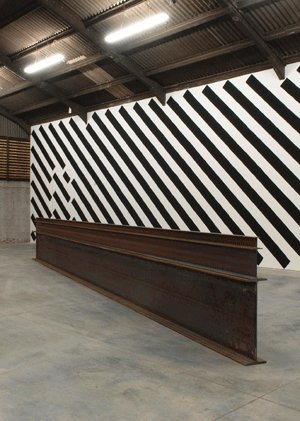Martin Creed
dal 5/9/2010 al 7/1/2011
Segnalato da
5/9/2010
Martin Creed
Hauser & Wirth, London
Hauser & Wirth continues its outdoor sculpture programme with Martin Creed's 'Work No. 700', three progressively slimmer steel I-beams balanced on top of each other. The rusted steel I-beams are twelve metres long and neatly stacked, discarding their previous functionality to form a whole in keeping with Creed's distinctive 'artistic logic'.

Hauser & Wirth continues its outdoor sculpture
programme with Martin Creed's 'Work No. 700'
(2007), three progressively slimmer steel I-beams
balanced on top of each other. The rusted steel
I-beams are twelve metres long and neatly
stacked, discarding their previous functionality to
form a whole in keeping with Creed's distinctive
'artistic logic'.
The piece is the largest realised work from Creed's
'Stack' series, a pyramidal compositional system
that the artist has applied to media as diverse as
cardboard boxes, plant pots, chairs, and painted
lines; each ordered according to size, ascending or
descending in incremental steps. Ordinary life in all
of its variety is submitted to this no-nonsense rigour,
creating works of art characterised by a comforting
simplicity. 'I think of a lot of my art as a simple frame
through which people can see all the chaos of the
world', Creed has said. 'It is like graph paper laid over
a chaotic scene, and that's how it can be helpful or a
comfort. Because life is just wild'.
Eschewing the label of 'conceptual artist', Creed is concerned with the stuff of the world and the range of
feelings this inspires. The use of industrial material and the scale of 'Work No. 700', as well as its formal
directness and economy of means, recalls the works of Minimalist artists. Yet in contrast to Minimalism's
quest for an aesthetic of purity, Creed's steel girders are left in their used, practical state. Order co-exists
with imperfection, with uncontrolled details that give the sculpture its character and particularity. According to
the critic Martin Herbert writing about this piece for Art Monthly, 'There is deep pleasure in this confluence of
discipline and forgiveness, the admirable lunge for perfection offset by a recognition that we cannot reach it in
real life'.
Creed was born in Wakefield, England in 1968, and grew up in Glasgow. He lives and works in London. He
has exhibited extensively worldwide, and in 2001 won the Turner Prize for 'The lights going on and off'. Recent
major solo exhibitions and projects include 'Things', The Common Guild, Glasgow (2010); 'Work No. 409', Royal
Festival Hall Elevator, London (2010); 'Work No. 245', Centre Pompidou-Metz (2009); Hiroshima City Museum
of Contemporary Art, Japan (2009); Ikon Gallery, Birmingham (2008); and the Duveen Commission, Tate Britain,
Hauser & Wirth
London, England (2008).
His work will be a major
presence at this year's Edinburgh Fringe Festival:
'Martin Creed Down Over Up' opens at The
Fruitmarket Gallery on 30 July, running until the end
of October; 'Work No. 1020', a dance performance
directed, choreographed and composed by Creed
which premiered last year at Sadler's Wells can be
seen at the Traverse Theatre on 8 August and 10
– 15 August; and a permanent sculpture by Creed
sees the city's historic Scotsman Steps resurfaced
with different marbles from all over the world. A
major solo exhibition of new work by Creed will
open at Hauser & Wirth's new Savile Row space in
January 2011.
'Martin Creed: Works', published by Thames & Hudson, will be available from the end of July. The publication is
a comprehensive survey of Creed's art featuring more than 700 works with a foreword by the artist and essays
by Germaine Greer, Matthew Higgs, Barry Humphries and others.
For press enquiries please contact Catherine Mason or Kristina McLean at
Calum Sutton PR on + 44 (0) 20 7183 3577 / catherine@suttonpr.com,
kristina@suttonpr.com or Hauser & Wirth on + 44 (0) 20 7399 9790 /
press@hauserwith.com
Opening 6 September 2010
Hauser & Wirth Outdoor Sculpture
Southwood Garden, St James's Church, 197 Piccadilly
Gallery hours: 10 am - 6 pm daily



